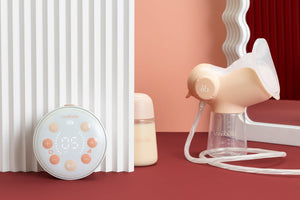If you’re looking for an effective and comfortable pumping experience, the first thing to think about is flange size. Many mothers focus on the pump itself, but without the correct flange, you could be using a state-of-the-art pump and still not get much milk. Using the wrong size flange can also be painful and leave a mark on your skin. What is a flange? The flange is the part of the pump that comes into contact with your breast. To know what size is the right fit for you, all you need to do is measure your nipple.
Measuring Your Nipple for Optimal Pumping
To find your ideal flange size, you need to measure the diameter of your nipple. This is a quick process you can do at home with one simple tool. Take a ruler or a measuring tape with millimeter markings and place it across the widest part of your nipple, not including the areola. Because breasts can be different, be sure to measure both nipples. Your nipple size can change over time, so if you start experiencing discomfort, it’s always a good idea to remeasure. Most pump companies have a nipple measuring tool on their websites, which you can print out to measure your nipple easily.
Why is Flange Size Important?
The correct flange size will help with both comfort and efficiency. When the flange fits properly, your nipple should be centered in the tunnel and move freely without rubbing against the sides. The suction should draw only your nipple into the tunnel, with little to no areola being pulled in. This ensures that the suction is concentrated where it needs to be, which helps stimulate milk flow and empty the breast effectively. A flange that is too small can cause pain, while one that is too large can lead to swelling and poor milk expression.
How to Choose Your Flange
Most breast pumps come with a standard range of flanges, often a 24mm or 28mm size. While these might work for some people, they will actually not work for most people. Flange sizes are directly related to your nipple diameter. It’s best to choose a flange size that is about 1-3 millimeters larger than your nipple size. Some mothers feel most comfortable and find the pumping most effective when using a flange that is exactly their nipple size. For example, if your nipple measures 21 millimeters, a 21-23 millimeter flange would likely be the right size. If your measurement is 25 millimeters, a 25- 27 millimeter flange will be a better fit. Many pump manufacturers offer a wide variety of sizes, so if the ones that came with your pump do not feel right, it’s worth seeking out other options.
An Innovative Solution to Flange Sizing
For mothers who are having a hard time finding the right size or whose nipple size fluctuates, the Annabella pump flange offers a new solution. Our innovative design features a resizable flange that can be adjusted to fit a wide range of nipple sizes. This adaptability means you won’t have to buy multiple flanges as your body changes, or if you are unsure of your exact measurement. To control flange size on the Annabella pump, all you need to do is turn the knob on the side of the flange so you can experiment with different sizes.







